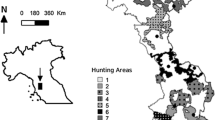Summary
Significantly more females reared on bedding soiled by different populations reproduced by 100 days of age than those reared on bedding soiled by the same populations (P<.1) or on clean bedding (P<.025) whereas the latter two groups did not differ significantly. Significantly greater percentages of females reproduced in both treatments maintained on soiled bedding than was true in the populations from which the bedding came. There were no significant differences between treatments in the weights of the reproductive organs (testes, seminal vesicles, ovaries, uteri) or in the numbers of corpora lutea or mature follicles in the ovaries of nulliparous females. The data suggest that if there were reproductively inhibiting pheromones influencing the population animals, they were altered or dissipated immediately after removal of the bedding from the population enclosures or that they were nonfunctional in the absence of the population animals. These data further suggest that the reproductive inhibition of population young is due to the presence of the populaton animals and that sociobiological factors within the populations act to prevent the reproductively stimulating influence of materials which may be present.
Similar content being viewed by others
References
Bronson, F.H. andB.E. Eleftheriou (1963) Influence of strange males on implantation in deermice.Gen. & Comp. Endo.3: 515–519.
Bruce, H.M. (1961) Time relations in the pregnancy-block inducae in mice by strange males.J. Rep. & Fert.2: 128–142.
Pedersfn, T. andH. Peters (1968) Proposal for a classification of oocytes in the mouse ovary.J. Rep. & Fert.17: 555–557.
Terman, C.R. (1965) A study of population growth and control exhibited in the laboratory by prairie deermice.Ecology46: 890–895.
Terman, C.R. (1968) Inhibition of reproductive maturation and function in laboratory populations prairie deermice: a test of pheromone influence.Ecology49: 1169–1172.
Terman, C.R. (1969a) Weight of selected organs of deer mice (Peromyscus maniculatus bairdii) from asymptotic laboratory populations.J. Mamm.50: 311–320.
Terman, C.R. (1969b) Pregnancy failure in female prairie deermice related to parity and social environment.An. Beh.17: 104–108.
Terman, C.R. (1969c) The influence of strange males on the growth of prairie deermouse embryos. (Abstract).Amer. Zool.9: 569.
Terman, C.R. (1973) Reproductive inhibition inhibition in asymptotic populations of prairie deermice.J. Rep. & Fert. Suppl.19: 457–463.
Terman, C.R. (1976) Laboratory studies of population regulation in prairie deermice.Cent. Sym. Science and Research. 190–220. Zool. Soc. of Philadelphia.
Author information
Authors and Affiliations
Rights and permissions
About this article
Cite this article
Kipps, P.L., Terman, C.R. The influence of pheromones produced by freely growing laboratory populations on the reproductive maturation of prairie deermice following prenatal and postnatal exposure. Res Popul Ecol 18, 261–266 (1977). https://doi.org/10.1007/BF02510852
Issue Date:
DOI: https://doi.org/10.1007/BF02510852




